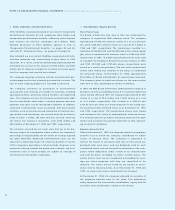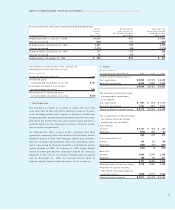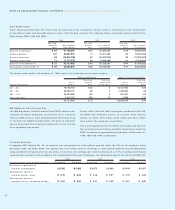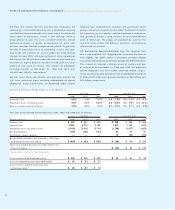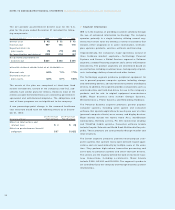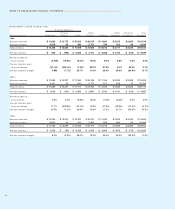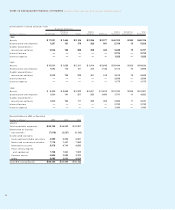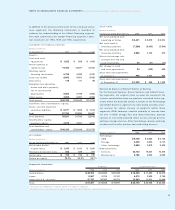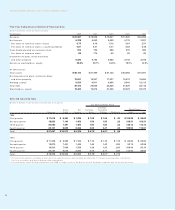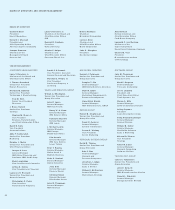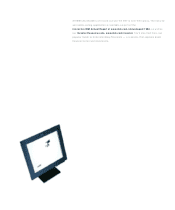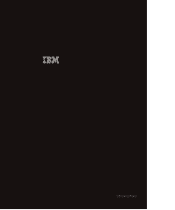IBM 1998 Annual Report Download - page 87
Download and view the complete annual report
Please find page 87 of the 1998 IBM annual report below. You can navigate through the pages in the report by either clicking on the pages listed below, or by using the keyword search tool below to find specific information within the annual report.
NOTES TO CONSOLIDATED FINANCIAL STATEMENTS International Business Machines Corporation and Subsidiary Companies
85
The Global Services segment is the world’s largest and most
versatile information technology services provider, supporting
computer hardware and software products, and providing pro-
fessional services to help customers of all sizes realize the full
value of information technology (IT). The segment provides its
customers with services that include business and IT consult-
ing, business transformational services like an ERP solution,
e-business services and full scope services like strategic out-
sourcing or Total Systems Management services. The Global
Services segment is uniquely suited to integrate the full range
of the company’s capabilities, including hardware, software
and research.
The Software segment delivers operating systems for the
company’s servers and middleware for IBM and non-IBM plat-
forms. Middleware includes application development, data
management, networking, systems management, transaction
processing, and messaging and collaboration. In addition to its
own development, product and marketing effort, the segment
supports more than 29,000 independent software vendors to
ensure that the company’s software and hardware offerings are
included in those partners’ solutions.
The Global Financing segment provides and facilitates a broad
array of financing services for the company, its customers and
its business partners. The primary focus is to leverage its
financial structuring, portfolio management and partnering
skills to expand the company’s customer and partner base.
Enterprise Investments segment provides a spectrum of initia-
tives in information technology solutions, supporting the hard-
ware, software and services segments of the company. The
segment develops unique products designed to meet specific
marketplace requirements and to complement the company’s
overall portfolio of products.
Segment revenue and pre-tax income include transactions
between the segments which are intended to reflect an arm’s-
length transfer at the best price available for comparable
external customers. Specifically, semiconductors and disk
drives are sourced internally from the Technology segment for
use in the manufacture of the Server segment and Personal
Systems segment products. Technology, hardware and soft-
ware used by the Global Services segment in outsourcing
engagements are sourced internally from the Technology,
Server, Personal Systems and Software segments. For the
internal use of information technology services, the Global
Services segment recovers cost as well as a reasonable fee
reflecting the arm’s-length value of providing the services. The
Global Services segment enters into arm’s-length leases at
prices equivalent to market rates with the Global Financing
segment to facilitate the acquisition of equipment used in
outsourcing engagements. All internal transaction prices are
reviewed and reset annually if appropriate.
The company extensively utilizes shared-staff concepts in
order to realize economies of scale and efficient use of
resources. As such, a significant amount of expense is shared
by all of the company’s segments. This expense represents
sales coverage, marketing and support functions such as
Accounting, Treasury, Procurement, Legal, Human Resources
and Billing and Collections. Where practical, shared expenses
are allocated based on measurable drivers of expense, e.g.,
Human Resources costs are allocated on headcount while
account coverage expenses are allocated on a revenue mix
that reflects the company’s sales commission plan. When a
clear and measurable driver cannot be identified, shared
expenses are allocated based on a financial basis consistent
with the company’s management system, e.g., image advertis-
ing is allocated based on the gross profit of the segments. The
unallocated corporate expenses primarily relate to expense
arising from certain acquisitions, indirect infrastructure reduc-
tions and currency exchange gains and losses recorded in net
income which are not allocated to the segments.
The following tables reflect the results of the segments con-
sistent with the company’s management system. These
results are not necessarily a depiction that is in conformity
with generally accepted accounting principles, e.g., employee
retirement plan costs are developed using actuarial assump-
tions on a country-by-country basis and allocated to the seg-
ments on headcount. A different result could be arrived at for
any segment if actuarial assumptions unique to each segment
were used. Performance measurement is based on income
before income taxes (pre-tax income). These results are used,
in part, by management, both in evaluating the performance
of, and in allocating resources to, each of the segments.



